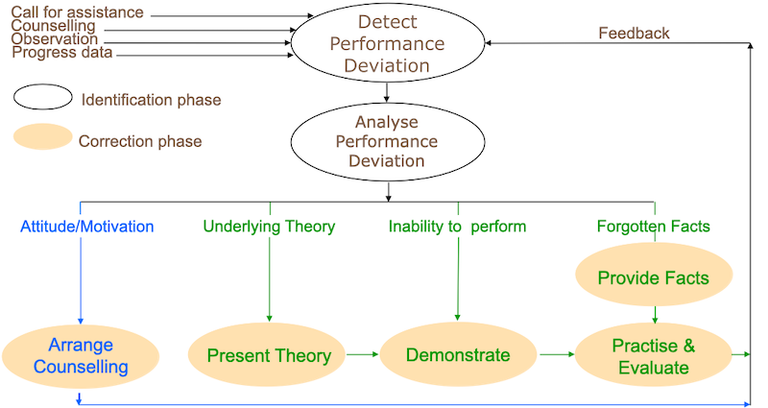The Essential Guide to Coaching

Photo by Christina @ wocintechchat.com on Unsplash
Coaching is a method of helping an individual to develop knowledge or skills. It involves having clear goals, modelling appropriate behaviour, and providing opportunities for practice and feedback.
There are three important prerequisites for successful coaching to occur:
- People must know what the desired behaviour is.
- They must be able to perform the behaviours.
- They must be willing to perform the behaviours.
Coaching communicates what the desired behaviour should be. It also teaches knowledge and skills so that a person can perform the desired behaviour. But if the person is unwilling to learn, or if you are dealing with an attitude problem or a ‘mental block’, then coaching skills may need to be supplemented by counselling skills.
Coaching Process
Experience shows that no two people have an identical level of skill deficiency. Therefore, the content of each coaching session will necessarily be different. There is no general ‘best way’ to conduct a coaching session. Coaching should be flexible. Sometimes, it is a long process — on other occasions, it takes little time. It is a continuous process. The immediate situation will determine your approach to any coaching session. Sometimes, you will have time to plan. On other occasions, you will have to act spontaneously.

Although your approach may change as the situation varies, the essential elements of effective coaching should never be neglected, or you may overlook some very important details.
There are five main phases in coaching:
- identification,
- presentation,
- assimilation,
- practice,
- feedback.
Identification
The identification phase involves you:
- Being sensitive to the signs which indicate that there is a need for coaching. These signs could be a call for assistance, the outcome of an appraisal session or your observations.
- Determining the performance discrepancy — i.e. what is the current level of performance, and what will be the goal of the coaching session?
- Identifying possible causes of the performance discrepancy will help you match the coaching to the need and determine whether counselling, rather than coaching, is appropriate.
Presentation
In a coaching context, a presentation is usually a demonstration. Still, it could include any underlying theory and use other media such as videos, books, exercises or e-courses.
Assimilation
After presenting the facts or demonstrating the skills, the temptation is to go straight on to the next task without allowing an opportunity for learning to take place. Even if the skills are practised, and feedback is given, the assimilation phase is often left out. By assimilation, we mean the process by which people are given time to make sense of what has just been heard and seen. It also allows them to fit this new knowledge into their existing model of the world. If coaching proceeds before they have had this opportunity, it will build on a very shaky foundation.
This opportunity can be provided in several ways. You can give them a couple of minutes to reflect or ask questions.
Practice
The fourth phase is to practise what has been demonstrated. Practice is essential to learning, and it is difficult to see how coaching can proceed without it.
Feedback
One of the most important coaching tasks is ensuring that sufficient feedback is available at the right time. We’ll discuss this more when we consider the level of intervention and the coaching of tacit skills and knowledge. It’s quite likely that you will need to repeat this process several times.
Level of intervention
One of the most difficult things to get right is the coach’s level of intervention. If the coach intervenes too late, people will flounder and lose confidence. If the coach intervenes too early, people will become frustrated and learn little. In extreme cases, coaches can end up doing the task themselves.
The best way to find the correct level of intervention is to err slightly towards intervening too late. (It is difficult to tell whether you intervened too early because they might have got on to the right track if you had not intervened.) This will also help coaches, who are experts on the task, resist the temptation to jump in and do the task themselves.
Facilitative Coaching
The coaching process we have described so far is directive and very effective for overt knowledge, relatively uncomplicated skills, and where a subject matter expert is coaching a novice.
But what happens when managers have to coach their people on skills they don’t possess or when the behaviour depends on tacit knowledge or subconscious skills? In this case, the coach doesn’t teach but facilitates the learning.
This style of coaching is probably best described by an exercise called CoachRing®. In this exercise, you coach someone to throw a tennis ball so that it lands in a one-metre-diameter circle from a distance of 25 metres.
If you used the directive coaching style, you would demonstrate the task and give feedback as your trainee attempts to throw the ball into the ring. You can imagine some of the feedback:
“No, not like that — like this:
“Hold the ball in the palm of your hand and smoothly swing your arm in an upward direction.”
The problem with this style of coaching, for this type of skill, is that you are trying to describe in words bodily sensations, which are often only on the brink of consciousness.
In the facilitative coaching style, you neither demonstrate nor give feedback. As you will see, the demonstration and feedback phases are still present but appear in a much more subtle form.
First, clarify the goal and then ask your trainee to throw the ball and watch where it lands. Ask the trainee to throw the ball again — making no conscious effort to change what they did on the first throw — and again observe where the ball lands. The process is repeated until the trainee is skilled at landing the ball in the ring.
It is difficult not to give praise and criticism, but the process depends on intrinsic feedback and the trainee not getting ‘wound up’ if the ball misses its target.
Originally published by LearningPages.org
Congratulations @learningpages! You have completed the following achievement on the Hive blockchain And have been rewarded with New badge(s)
Your next target is to reach 700 upvotes.
You can view your badges on your board and compare yourself to others in the Ranking
If you no longer want to receive notifications, reply to this comment with the word
STOPCheck out our last posts: